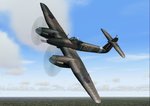trackend
Chief Master Sergeant
In 1936 OR (operational requirement) 31 from the MOD requested a day/night fighter with up to eight machine guns the tender from Westlands with the P9 armed with 4 20mm Hispano cannons and explosive rounds impressed the air staff although the use of a twin engine layout had many critics. The competition came from Boulton Paul P88, Bristol 153A, Hawker F37/35 and Supermarine's 312 and 313.
The 313 from Mitchells design group was favoured but eventually because of the advanced nature of Teddy Petters design the P9 won also the Spitfire took up much of Supermarines production facilities.
Initially the Whirlwind was designed with twin fins and powered by RR Kestral (later to become Peregrine) engines these were also to be handed engines to reduce torque (although dropped later). After wind tunnel testing the single tail fin was adopted and alterered more that once until a high lift tail proved to be the most effective.
Also the Idea of using exhaust ducts near the cockpit for heating then passing them through the fuel tanks to reduce drag was not favoured by many of the design team and even less so by the test pilots.
The first maiden flight was october 1938 and after several near disasters including the exhaust burning through an aileron control rod, a redesign was carried out placing the exhaust more conventionally to the relief of the flyers.
The bubble canopy was very popular amoungst the pilots giving excellent vision compared to its comtemporaries at the time.
The success of the Spitfire was to be the undoing of the Whirlwind.
Various gun configurations were trialed including a 37mm (to become 40mm) tank buster and twelve nose mounted browning 303 machine guns in three banks of four. At low level performing better than its rivals the Whirlwind was let down by production problems.
200 units were order but in the end only 114 saw completion the Peregrine engines were not as reliable as the Merlin and Rolls Royce production concentrated mainly on these so delivery times fell behind. It was proposed that Merlins be fitted into the Whirlwind but the airframe alterations need were prohibitive. Abandoning work on the Peregrine Rolls Royce doomed the Whirlwind to a small production run.
In 1938 it could out dive the Spitfire accelerating to its limited speed of 420mph far quicker.
Below 10,000ft it could out perform both the Spitfire 1 and the Hurricane and above were their equals.
The last mission flown was in 1943 but as remarked by Tony Battle in Flypast "what might a dozen combat ready Whirlwind Squadrons have achieved during the massive air battles in summer 1940?"
The Whirlwind had the making of a great fighter, indeed it was a great fighter but never saw it in numbers large enough to prove it.
Sources: Fighters by William Green Gordon Swanborough Reap the Whirlwind by Tony Buttler
The 313 from Mitchells design group was favoured but eventually because of the advanced nature of Teddy Petters design the P9 won also the Spitfire took up much of Supermarines production facilities.
Initially the Whirlwind was designed with twin fins and powered by RR Kestral (later to become Peregrine) engines these were also to be handed engines to reduce torque (although dropped later). After wind tunnel testing the single tail fin was adopted and alterered more that once until a high lift tail proved to be the most effective.
Also the Idea of using exhaust ducts near the cockpit for heating then passing them through the fuel tanks to reduce drag was not favoured by many of the design team and even less so by the test pilots.
The first maiden flight was october 1938 and after several near disasters including the exhaust burning through an aileron control rod, a redesign was carried out placing the exhaust more conventionally to the relief of the flyers.
The bubble canopy was very popular amoungst the pilots giving excellent vision compared to its comtemporaries at the time.
The success of the Spitfire was to be the undoing of the Whirlwind.
Various gun configurations were trialed including a 37mm (to become 40mm) tank buster and twelve nose mounted browning 303 machine guns in three banks of four. At low level performing better than its rivals the Whirlwind was let down by production problems.
200 units were order but in the end only 114 saw completion the Peregrine engines were not as reliable as the Merlin and Rolls Royce production concentrated mainly on these so delivery times fell behind. It was proposed that Merlins be fitted into the Whirlwind but the airframe alterations need were prohibitive. Abandoning work on the Peregrine Rolls Royce doomed the Whirlwind to a small production run.
In 1938 it could out dive the Spitfire accelerating to its limited speed of 420mph far quicker.
Below 10,000ft it could out perform both the Spitfire 1 and the Hurricane and above were their equals.
The last mission flown was in 1943 but as remarked by Tony Battle in Flypast "what might a dozen combat ready Whirlwind Squadrons have achieved during the massive air battles in summer 1940?"
The Whirlwind had the making of a great fighter, indeed it was a great fighter but never saw it in numbers large enough to prove it.
Sources: Fighters by William Green Gordon Swanborough Reap the Whirlwind by Tony Buttler


